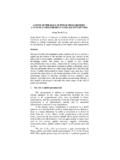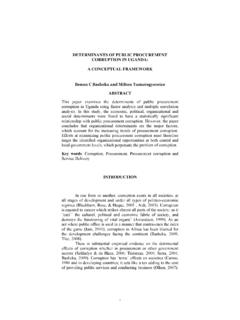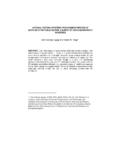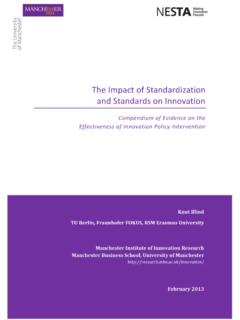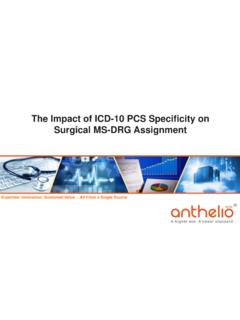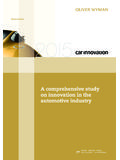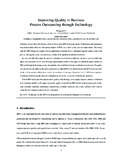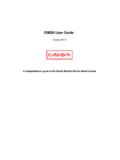Transcription of PUBLIC E-PROCUREMENT - DEFINE, MEASURE AND …
1 PUBLIC E-PROCUREMENT - define , MEASURE AND OPTIMIZE ORGANIZATIONAL BENEFITS. Francesco Gardenal Francesco Gardenal, MSc in Economics and Management of PUBLIC Administration and International Institutions. Member of Regional procurement Agency, Lombardia, Italy. His research interests are in PUBLIC procurement , change management, game theory and e-government. ABSTRACT This paper analyzes how E-PROCUREMENT could impact the purchasing process of PUBLIC Services. It aims at proposing a model pinpointing and quantifying performance benefits among organizations.
2 A review of existing literature about E-PROCUREMENT and the impacts of IT-based innovations has been taken into account. The critical factors of success are examined, and six of the main impact dimensions of electronic procurement are precisely set out. The key contribution of this paper is a model, consisting of a specific measurement framework -for each impact dimension- and a cockpit. These instruments are employed to monitor the performance of procurement personnel and the overall effect of the implementation of E-PROCUREMENT .
3 This model has been applied through an analysis of the PUBLIC healthcare sector in Lombardia (the Region of Lombardy). The results are herewith exposed. SUMMARY 1. INTRODUCTION 3 2. E-PROCUREMENT AND ORGANIZATIONAL RENEWAL 3 E-PROCUREMENT Impacts 5 3 PERFORMANCE MEASUREMENT MODEL 9 Efficiency 9 Effectiveness 10 Dematerialization 10 Transparency 11 Competitiveness 12 Governance 12 Method 13 4 SURVEY CONDUCTED ON LOMBARDIA PUBLIC HEALTHCARE SERVICE 14 Why Surveying Lombardia PUBLIC Healthcare Service 15 Findings of the Survey 16 Cockpit of Key Indicators 20 5 CONCLUSIONS 22 6 REFERENCES 23 1.
4 INTRODUCTION E-PROCUREMENT is a specific set of instruments, technologies and organizational solutions supporting PUBLIC procurement processes, particularly considering the possibility to manage tendering procedures and auctions online (e-tendering, e-auctioning). This paper analyzes the impacts that E-PROCUREMENT could produce in PUBLIC supply chains, the main goal is to define a model to MEASURE the performances of PUBLIC procurement activities, by quantifying organizational benefits deriving from introducing this innovation.
5 Literature about IT based innovations has been reviewed to identify the critical success factors (CSF) to achieve the benefits related to the use of electronic instruments in procurement . Thus, a definition of six impact dimensions on organizational performances is provided: efficiency, effectiveness, transparency, competitiveness, governance and dematerialization. Each of the six impact dimensions is part of the performance measurement model herewith proposed; they are described by a set of indicators.
6 Specialized literature lacks a similar model, therefore the paper identifies both its characteristics and its usage modalities. The results of the first survey based on this methodology are given, the survey has been conducted on Lombardia PUBLIC Healthcare Service. The data will highlight the interesting benefits that the healthcare sector is already experiencing, thanks to the usage of E-PROCUREMENT web platforms, although the implementation of this instruments has been carried out only recently.
7 2. E-PROCUREMENT AND ORGANIZATIONAL RENEWAL Literature and specific research contributions on E-PROCUREMENT and the implementation of these instruments begun to develop only during the last decade, especially considering PUBLIC Services. The first papers dedicated to these issues date back the end of the 90s, the authors stressed the importance of employing IT in procurement activities and handling the benefits. It has been highlighted that E-PROCUREMENT has to be evaluated in its complexity, which encompasses numerous goals: to rationalize expenditure, to reduce administrative confusion and costs, to foster operational efficiency, to strengthen organizations network vision and technological collaboration with business partners, even to completely automate certain procurement activities (Croom, 2000; Gamble, 1999; Greenemeier, 2000 and Murray, 2001).
8 In order to achieve these goals, the implementation of E-PROCUREMENT has to be carried out alongside a complete revision of procurement processes, which would include an accurate selection of suppliers, strategic bargaining of contracts, monitoring of performance, both of buyers and suppliers. Moreover, it is necessary to move towards a systemic usage of this technological innovation, with a continuous flux of electronic purchasing activities affecting important volumes of expenditure (Ramayah, Zbib, Jantan e Koh, 2006).
9 The pros and cons of IT based innovations in complex organizations have encouraged a plethora of studies that investigated these impacts under a variety of points of view. The contributions of Davenport and Andersen have been particularly considered to develop the procurement performance measurement model presented in this paper. T. H. Davenport (1994) defines 9 principal groups of specific effects of IT on organizational processes: automating (eliminating or reducing drastically the effort of human resources), informative (generating more information and allow a better understanding of it), sequential (modifying the sequence of the process and the activities that are part of them), of control (improving monitoring), analytical (improving the understanding of the phenomena), geographical (improving the ability to coordinate remote processes)
10 , integrative (assuring coordination among tasks and processes), intellectual (getting and spreading knowledge), disintermediation (reducing redundancy and intermediate activities). In e-Government in action, Andersen analyzes the subject in a broader perspective: Information Technology produces direct effects on organizational skills, as far as effectiveness and efficiency of the processes are concerned. On the other hand, IT indirectly affects organizational interactions, coordination and cooperation, interaction models, internal control and organizational power.


